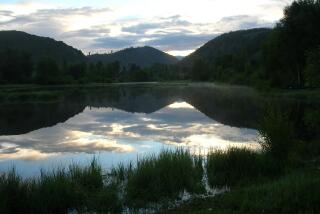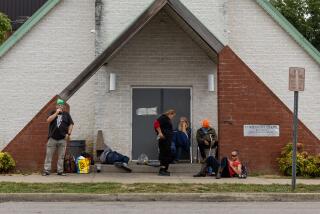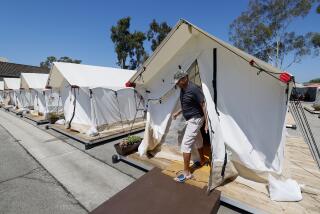S. Dakota Tries Novel Idea to Keep Small Towns Alive
- Share via
WHITE LAKE, S.D. — This town wants kids, badly. And it’s hoping burglars and dope pushers just might bring them here.
White Lake, population 419, is like a lot of South Dakota farm towns: tidy and friendly and graying fast. This is a was-born-and-will-die-here kind of place, and most of the lifelong residents are well into retirement. So to keep the town going, a new generation must put down roots.
It’s not that there’s no interest; urban parents are eager to send their children to school here, where a big class is 17 kids and where every student takes a daily music lesson.
But there’s no place for these young families to live. Homes just don’t go up for sale very often here. Folks tend to stick where they’ve settled. And new construction is all but unheard of in a dusty speck on the map like White Lake.
This is where the drug dealers come in.
They and other inmates at the medium-security state prison in Springfield have for the last three years been building sturdy two-bedroom bungalows under a plan that Gov. William Janklow hatched to revive South Dakota’s flagging small towns.
The homes are available at cost, which isn’t much when the laborers earn 25 cents an hour, to any elderly or disabled South Dakota resident.
The idea is simple. Tired of maintaining big farmhouses with huge lawns and daunting staircases, senior citizens should be eager to move into the compact, wheelchair-accessible bungalows. Once they do, they can put their former homes on the market, giving younger families an opportunity to raise their kids in the clean air and chatty camaraderie of communities like White Lake.
“I thought this would help maintain the viability of our small towns,” Janklow said. “I can’t save small-town South Dakota, no matter what I do. [But] I can give people who want to move there a decent, affordable place to live.”
Not Everyone Is Buying In
Results so far have been mixed.
The state has sold 407 inmate-built bungalows for about $20,000 each, when prices around White Lake can range from $30,000 for an older home to more than $100,000 for new construction. Most of the bungalows have been delivered to rural towns, but Janklow also has permitted seniors in big cities to buy them. In more than half the transactions, the elderly purchasers did sell their former homes to young families. (The remaining cases mostly involved seniors who moved from out of state to be near relatives, or who turned their old houses over to their children.)
Wayne and Mardell Ebsen count themselves among the success stories. They bought an inmate-built bungalow, which they fondly dubbed their “jail lodge,” to retire in along the Missouri River. Then they sold their four-bedroom house in the mid-sized city of Vermillion to a young couple from Nebraska.
They felt they were doing their part to encourage a new generation to take a look at South Dakota, a state with five times as many cows as people.
“We’ve watched these small towns fade,” said Mardell Ebsen, 59. Much of rural South Dakota is now “just a bunch of retired people. There’s nothing to keep the young folks around. This helps.”
Although state officials call the governor’s program a success, it has not worked exactly as planned in White Lake, a modest, no-frills town where the ad on the lone cafe reads, simply, “Grub.”
The town’s all-volunteer development agency bought one of the 760-square-foot bungalows and set it on a foundation with a garage. Three seniors have expressed interest in buying it, but it’s proved much harder than expected to nudge them out of the houses they’ve lived in for decades. They may curse the stairs every time they climb them. They may have no use for the three spare bedrooms. Still, they don’t want to leave their memories. They don’t want to sell their furniture. And they don’t want to mess with another mortgage.
As 62-year-old Joyce Ehlers, who runs the general store here, put it: “Why would anyone in their right mind want to move into a little house and start all over?”
An hour’s drive west in Chamberlain, a town of 2,500 people on a bluff above the Missouri River, Phylis and Mel Brunken wrestled with that same question before deciding to give up a roomy split-level house that they and their children built. At 71, Phylis, a retired teacher, could no longer handle the stairs. So she and her husband bought a pale yellow bungalow with a wheelchair-accessible shower. Then they had it delivered to a lot that overlooks the town baseball diamond, so Mel can keep tabs on Little League scores from his porch.
Total cost: $19,000. Only complaint: the color of the interior doors, which the Brunkens call a depressing “prison gray.” Otherwise, they’re thrilled with their “governor’s home.” “I think we’ll be able to stay here for a long time,” Phylis Brunken said.
Best of all, their old home went to a young family they know. The wife, Stana Smith, used to be Phylis’ student. The Smiths, who have two children, had scoured Chamberlain’s real estate ads for four years, unable to find a decent home they could afford. “Housing is a tremendous problem in this town,” said Steve Smith, a lawyer. Janklow’s program, he said, “does a nice job” of helping.
Contractors Say They Can’t Compete
Although the program was intended for towns like White Lake and Chamberlain, it has expanded to meet demand in bigger cities. And that’s infuriated some contractors, who say $2-a-day inmate labor is stealing their business.
“We absolutely cannot compete,” contractor Greg Lebert complained. “If the economy was popping up houses all over the place, that would be one thing, but the housing market in town is pretty slow right now.” The state has delivered four prison bungalows to Lebert’s home of Watertown (population 20,000) and, he reasoned, those are four homes that he and his fellow carpenters won’t be building.
“I never saw any issue create as much uproar as this one,” said Glen Kane, president of the South Dakota Home Builders Assn. “My main concern is, what is the government doing in private enterprise?”
Janklow responds that there’s plenty of business for everyone, especially in a state with an enviable unemployment rate of just 2.4%. Plus, while the homes are available to any senior citizen, he argues that only those of modest means--not the best customers for private developers--will likely be interested in a bungalow.
The way Janklow sees it--and he emphasizes his credentials as a conservative Republican--he’s responding to a very real social need, not trying to drive contractors out of work. “I accomplish a lot of objectives doing this,” he said.
One of those objectives is to teach inmates skills they can use when released. The convicts construct or install every component of the homes, from the plumbing to the insulation to the oak kitchen cabinets. Despite the low wages, there’s always a waiting list in the prison for the 75 construction jobs.
Giving inmates work is nothing new; convicts in other states apply for jobs translating texts into Braille, etching stained glass, manufacturing boxer shorts and tending cattle. But Janklow is especially determined to put his state’s convicts to good use to solve some of the problems peculiar to rural life. In addition to the bungalows, they build day-care centers for small towns--another job that infuriates private contractors. The inmates also have just finished wiring all the state’s hospitals and schools with fiber-optic cables.
Here in White Lake, the prisoners have installed two computer labs in the squat brick schoolhouse that serves kindergartners through 12th-graders. Every classroom is connected to the Internet. And Supt. Berle Johnson plans to start “distance learning,” so kids can take courses such as upper-level Spanish through video feeds from bigger cities.
Johnson believes the school, whose students live up to 18 miles away, will prove to be White Lake’s savior. “This is going to be the big draw for families to come here.”
“That is, if we can find the place to put them.”
Unless the housing crunch eases and families start moving in, White Lake’s enrollment is expected to dip from 178 to 152 in the next five years. As the school shrinks, so will funding. Eventually, it may be impossible to sustain.
And without a school, White Lake will surely shrivel.
Another Plan to Lure Families
The governor’s program offers one potential way out. Another is banker Craig Dodds’ plan to get the town in the construction business. Under his guidance, the White Lake development authority recently bought an 18-acre alfalfa field and is building large, single-family homes there; the first four already have been sold. To lure still more families, Dodds says he’ll sell lots for $1 to parents looking to put down roots.
Dodds also hopes to persuade Janklow to offer the bungalows to young families. They would make perfect starter homes, he reasons.
In fact, the governor’s already planning to make the bungalows available to families, even though he expects a big battle with the building industry.
So those dope pushers just might save White Lake yet.
The prospect has Dodds enthusiastic.
“Our goal is to add three new families a year. Our industry here is not going to be manufacturing. It’s not going to be computer chips. It’s going to be housing and it’s going to be kids. We need kids.”
More to Read
Sign up for Essential California
The most important California stories and recommendations in your inbox every morning.
You may occasionally receive promotional content from the Los Angeles Times.










